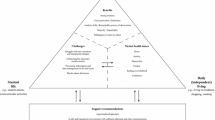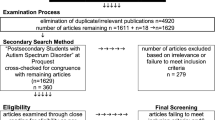Abstract
Little research directly examines the needs of post-secondary students with ASD. The experiences and support needs of 23 students with ASD enrolled in two universities and four colleges, and 15 family members were explored in 15 semi-structured focus groups. Thematic analysis identified five themes: core ASD features, co-morbid conditions, transition, disclosure, and services and support. Most students felt educationally but not socially supported; most families felt support was poor in both areas. Transition from secondary school was often unplanned, and disclosure of diagnosis usually occurred after enrolment, often following a significant problem. Many parents provided substantial student support. Thus disclosure of ASD diagnosis and meeting the individual needs of these students are important considerations as higher education enrolments increase.
Similar content being viewed by others
Notes
Extracts from the focus groups use the following conventions:
Short pause: …;
Words omitted to shorten quote: (…);
Explanatory information added by authors: [text];
Multiple speakers: Student 1 etc.
References
Adreon, D., & Durocher, J. S. (2007). Evaluating the college transition needs of individuals with high-functioning autism spectrum disorders. Intervention in School and Clinic, 42(5), 271–279.
Allen, C. W., Silove, N., Williams, K., & Hutchins, P. (2007). Validity of the Social Communication Questionnaire in assessing risk of autism in preschool children with developmental problems. Journal of Autism and Developmental Disorders, 37(7), 1272–1278.
American Psychiatric Association. (2013). Diagnostic and statistical manual of mental disorders (5th ed.). Arlington, VA: American Psychiatric Association.
Attwood, T. (2007). The complete guide to Asperger’s syndrome. London: Jessica Kingsley Publishers.
Baron-Cohen, S., Wheelwright, S., Skinner, R., Martin, J., & Clubley, E. (2001). The Autism-Spectrum Quotient (AQ): Evidence from Asperger syndrome/high-functioning autism, males and females, scientists and mathematicians. Journal of Autism and Developmental Disorders, 31(1), 5–17.
Bellini, S. (2004). Social skill deficits and anxiety in high-functioning adolescents with autism spectrum disorders. Focus on Autism and Other Developmental Disabilities, 19(2), 78–86.
Billstedt, E., Gillberg, I. C., & Gillberg, C. (2005). Autism after adolescence: Population-based 13- to 22-year follow-up study of 120 individuals with autism diagnosed in childhood. Journal of Autism and Developmental Disorders, 35(3), 351–360.
Boyd, K., Woodbury-Smith, M., & Szatmari, P. (2011). Managing anxiety and depressive symptoms in adults with autism-spectrum disorders. Journal of Psychiatry and Neuroscience, 36(4), E35–E36.
Brugha, T. S., McManus, S., Bankart, J., Scott, F., Purdon, S., Smith, J., et al. (2011). Epidemiology of autism spectrum disorders in adults in the community in England. Archives of General Psychiatry, 68(5), 459–465.
Campbell, T. A., & Campbell, D. E. (1997). Faculty/student mentoring program: Effects on academic performance and retention. Research in Higher Education, 28(6), 727–742.
Centers for Disease Control and Prevention. (2014). Prevalence of autism spectrum disorder among children aged 8 years—autism and developmental disabilities monitoring network, 11 sites, United States, 2010. Morbidity and Mortality Weekly Report, 63(2), 1.
Crisp, G. (2010). The impact of mentoring on the success of community college students. The Review of Higher Education, 34(1), 39–60.
Dillon, M. R. (2007). Creating supports for college students with Asperger syndrome through collaboration. College Student Journal, 41(2), 499–504.
Ellison, L. M. (2013). Assessing the readiness of higher education to instruct and support students with Asperger’s Disorder (Doctoral dissertation). Retrieved from http://mds.marshall.edu/cgi/viewcontent.cgi?article=1428&context=etd
Farley, M. A., McMahon, W. M., Fombonne, E., Jenson, W. R., Miller, J., Gardner, M., et al. (2009). Twenty-year outcome for individuals with autism and average or near-average cognitive abilities. Autism Research, 2(2), 109–118.
Getzel, E. E. (2008). Addressing the persistence and retention of students with disabilities in higher education: Incorporating key strategies and supports on campus. Exceptionality, 16(4), 207–219.
Glennon, T. J. (2001). The stress of the university experience for students with Asperger syndrome. Work, 17(3), 183–190. Retrieved from http://www.iospress.nl/journal/work/
Hart, D., Grigal, M., & Weir, C. (2010). Expanding the paradigm: Postsecondary education options for individuals with autism spectrum disorder and intellectual disabilities. Focus on Autism and Other Developmental Disabilities, 25(2), 134–150.
Hill, E. L. (2004). Executive dysfunction in autism. Trends in Cognitive Sciences, 8(1), 26–32.
Howlin, P., Goode, S., Hutton, J., & Rutter, M. (2004). Adult outcome for children with autism. Journal of Child Psychology and Psychiatry, 45(2), 212–229.
Howlin, P., & Moss, P. (2012). Adults with autism spectrum disorders. Canadian Journal of Psychiatry, 57(5), 275–283.
Jarbrink, K., McCrone, P., Fombonne, F., Zanden, H., & Knapp, M. (2007). Cost impact of young adults with high-functioning autistic spectrum disorder. Research in Developmental Disabilities, 28, 94–104.
Jobe, L. E., & White, S. W. (2007). Loneliness, social relationships and a broader autism phenotype in college students. Personality and Individual Differences, 42(8), 1479–1489.
Knapp, M., Romeo, R., & Beecham, J. (2009). Economic cost of autism in the UK. Autism, 13(3), 317–336.
Knott, F., & Taylor, A. (2014). Life at university with Asperger syndrome: A comparison of student and staff perspectives. International Journal of Inclusive Education, 18(4), 411–426.
Magiati, I., Tay, X. W., & Howlin, P. (2014). Cognitive, language, social and behavioural outcomes in adults with autism spectrum disorders: A systematic review of longitudinal follow-up studies in adulthood. Clinical Psychology Review, 34(1), 73–86.
Mayes, S. D., & Calhoun, S. L. (2003). Ability profiles in children with autism. Autism, 6, 65–80.
Ness, B. M. (2013). Supporting self-regulated learning for college students with Asperger syndrome: Exploring the “Strategies for college learning” model. Mentoring and Tutoring: Partnership in Learning, 21(4), 356–377.
Pancer, S. M., Hunsberger, B., Pratt, M. W., & Alisat, S. (2000). Cognitive complexity of expectations and adjustment to university in the first year. Journal of Adolescent Research, 15(1), 38–57.
QSR International. (2010). NVivo qualitative data analysis software (Version 9) [Computer software]. Provo, UT: Qualtrics.
Richdale, A., Dissanayake, C., & Cai, R. Y. (2012). Supporting transition to and participation in tertiary education for students with an autism spectrum disorder. Report for the Department of Human Services Victoria.
Roberts, K. D. (2010). Topic areas to consider when planning transition from high school to postsecondary education for students with autism spectrum disorders. Focus on Autism and Other Developmental Disabilities, 25(3), 158–162.
Rutter, M., Bailey, A., & Lord, C. (2003). Social Communication Questionnaire (SCQ). Los Angeles: Western Psychological Services.
Seltzer, M. M., Shattuck, P., Abbeduto, L., & Greenberg, J. S. (2004). Trajectory of developing in adolescents and adults with autism. Mental Retardation and Developmental Disabilities Research Reviews, 10(4), 234–247.
Shattuck, P. T., Narendorf, S. C., Cooper, B., Sterzing, P. R., Wagner, M., & Taylor, J. L. (2012). Postsecondary education and employment among youth with an autism spectrum disorder. Pediatrics, 129(6), 1042–1049.
Sorrentino, D. M. (2006). The SEEK mentoring program: An application of the goal setting theory. Journal of College Student Retention: Research, Theory, and Practice, 8(2), 241–250.
Taylor, J. L., & Seltzer, M. M. (2010). Changes in the autism behavioral phenotype during the transition to adulthood. Journal of Autism and Developmental Disorders, 40(12), 1431–1446.
Van Bergeijk, E., Klin, A., & Volkmar, F. (2008). Supporting more able students on the autism spectrum: College and beyond. Journal of Autism and Developmental Disorders, 38(7), 1359–1370.
Van Roekel, E., Scholte, R. H., & Didden, R. (2010). Bullying among adolescents with autism spectrum disorders: Prevalence and perception. Journal of Autism and Developmental Disorders, 40(1), 63–73.
Wagner, M., Kutash, K., Duchnowski, A. J., Epstein, M. H., & Sumi, W. C. (2005). The children and youth we serve: A national picture of the characteristics of students with emotional disturbances receiving special education. Journal of Emotional and Behavioral Disorders, 13(2), 79–96.
Wei, X., Yu, J. W., Shattuck, P., McCracken, M., & Blackorby, J. (2013). Science, technology, engineering, and mathematics (STEM) participation among college students with an autism spectrum disorder. Journal of Autism and Developmental Disorders, 43(7), 1539–1546.
White, S. W., Ollendick, T. H., & Bray, B. C. (2011). College students on the autism spectrum: Prevalence and associated problems. Autism, 15(6), 683–701.
Woodbury-Smith, M. R., Robinson, J., Wheelwright, S., & Baron-Cohen, S. (2005). Screening adults for Asperger syndrome using the AQ: A preliminary study of its diagnostic validity in clinical practice. Journal of Autism and Developmental Disorders, 35(3), 331–335.
Zager, D., & Alpern, C. S. (2010). College-based inclusion programming for transition-age students with autism. Focus on Autism and Other Developmental Disabilities, 25(3), 151–157.
Acknowledgments
This research is part of a larger, multi-component study funded by the Victorian Government. The authors would like to thank the students and family members who participated in this study, as well as disability support staff at the participating universities and TAFE colleges. We would also like to thank Ms. Lindsay Pamment for assistance with the larger focus groups, Professor Cheryl Dissanayake for her contributions to the original research from which the information reported here is drawn, and Dr. Mirko Uljarevic for helpful comments on the final draft of this paper.
Author Contributions
Both authors contributed to the analysis of the data. RYC wrote the first draft and after successive edits by both authors, ALR completed and submitted the final draft.
Author information
Authors and Affiliations
Corresponding author
Ethics declarations
Conflict of interest
The authors have no conflict of interest to disclose.
Ethical Standard
As stated in the Procedure, ethics approval was obtained from the authors’ university Human Ethics committee, permissions as required were obtained from other institutions, participation was voluntary and all participants provided informed consent.
Rights and permissions
About this article
Cite this article
Cai, R.Y., Richdale, A.L. Educational Experiences and Needs of Higher Education Students with Autism Spectrum Disorder. J Autism Dev Disord 46, 31–41 (2016). https://doi.org/10.1007/s10803-015-2535-1
Published:
Issue Date:
DOI: https://doi.org/10.1007/s10803-015-2535-1




